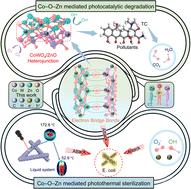Engineering Co–O–Zn bonds in CoWO4/ZnO heterojunctions toward boosted charge separation and photothermal antibacterial activity
IF 9.5
2区 材料科学
Q1 CHEMISTRY, PHYSICAL
引用次数: 0
Abstract
Engineering electron-bridge bonds at heterojunction interfaces offers an effective strategy to enhance photocatalytic performance. This paper reports the selective construction of Co–O–Zn electron-bridge bonds in CoWO4/ZnO heterostructured nanotubes via an electrospinning–calcination process. The preferential formation of Co–O–Zn bonds over W–O–Zn bonds at CoWO4 (100)/ZnO (101) interfaces, accompanied by electron transfer from Zn to Co, indicates that h+-rich Zn and e−-rich Co sites serve as oxidation and reduction centers, respectively. The optimized CoWO4/ZnO-0.5 composite exhibits dual photocatalytic functionality, achieving 95% UV-Vis tetracycline degradation within 140 min and 91% NIR degradation within 240 min, with strong cycling stability (efficiency loss of only 5.21% and 4.71% after five cycles, respectively). A fluorescence lifetime of 1.37 ns provides direct evidence of accelerated charge-transfer kinetics through Co–O–Zn electron bridges, enabling rapid separation of photogenerated electron–hole pairs. ECOSAR simulations confirm that degradation products are up to 26.2-fold less toxic than the original compound. Under 0.5 W cm−2 laser irradiation, the material demonstrates pronounced photothermal properties, with rapid heating to 172.6 °C (solid, 100 s) and 52.9 °C (liquid, 150 s). The integration of photocatalysis and photothermal sterilization through directional bond engineering provides mechanistic insights into dual-function enhancement and establishes an atomic-level framework for designing heterojunctions for energy and sustainability applications.

CoWO4/ZnO异质结中Co-O-Zn键的工程设计促进了电荷分离和光热抗菌活性
工程电子桥键在异质结界面提供了有效的策略,以提高光催化性能。本文报道了采用电纺丝-煅烧工艺在CoWO4/ZnO异质结构纳米管中选择性构建Co-O-Zn电子桥键。CoWO4 (100)/ZnO(101)界面上Co - o - Zn键优先于W-O-Zn键的形成,并伴有电子从Zn向Co的转移,表明富h+ Zn和富e−Co分别是氧化和还原中心。优化后的CoWO4/ZnO-0.5复合材料具有双光催化功能,在140 min内实现了95%的紫外-可见四环素降解,在240 min内实现了91%的近红外降解,具有较强的循环稳定性(循环5次后效率损失仅为5.21%和4.71%)。1.37 ns的荧光寿命提供了通过Co-O-Zn电子桥加速电荷转移动力学的直接证据,使光生电子-空穴对能够快速分离。ECOSAR模拟证实,降解产物的毒性比原始化合物低26.2倍。在0.5 W cm−2激光照射下,材料表现出明显的光热性能,可快速加热到172.6°C(固体,100 s)和52.9°C(液体,150 s)。通过定向键工程将光催化和光热灭菌结合起来,为双功能增强提供了机制见解,并为设计能源和可持续性应用的异质结建立了原子级框架。
本文章由计算机程序翻译,如有差异,请以英文原文为准。
求助全文
约1分钟内获得全文
求助全文
来源期刊

Journal of Materials Chemistry A
CHEMISTRY, PHYSICAL-ENERGY & FUELS
CiteScore
19.50
自引率
5.00%
发文量
1892
审稿时长
1.5 months
期刊介绍:
The Journal of Materials Chemistry A, B & C covers a wide range of high-quality studies in the field of materials chemistry, with each section focusing on specific applications of the materials studied. Journal of Materials Chemistry A emphasizes applications in energy and sustainability, including topics such as artificial photosynthesis, batteries, and fuel cells. Journal of Materials Chemistry B focuses on applications in biology and medicine, while Journal of Materials Chemistry C covers applications in optical, magnetic, and electronic devices. Example topic areas within the scope of Journal of Materials Chemistry A include catalysis, green/sustainable materials, sensors, and water treatment, among others.
 求助内容:
求助内容: 应助结果提醒方式:
应助结果提醒方式:


